This week’s post is packed full of insights and findings from the major surveys spotted by our team in recent months that you need to know about to inform your 2024 marketing campaigns.
In this quick read, you can learn about which channels provide the greatest engagement for your marketing campaigns, the value of email and how frequently prospects want to receive information, why prospective students attend open days, how marketing teams are responding to emerging trends, and more.
Quick Takeaways
- Prioritise YouTube and TikTok for targeting prospective students.
- 2024 is the year to experiment with AI to support your social media management activities.
- Email marketing is still highly effective and response rates should be optimized.
- Parents and families are keen on weekly communications from the institutions their children attend.
They’re also open to the use of text messages for updates and would welcome more channels for connecting with institutions. - The top reasons for attending open days and events are to assess the vibe of a university and its accommodations, and what a typical day might look like.
- Students are more interested in enriching their lives than in increasing their income potential.
- Marketing and digital teams responding to surveys plan to increase their investment in 2024 in TikTok, automation, and video content.
1. Gen-Z, social media, and AI
Social media use with Gen Z
Media Nations 2023 Report published a few months ago, found that, in the UK at least, TikTok continues to come out on top for longest watch time in 15-24 age groups, closely followed by time spent in Snapchat and YouTube.
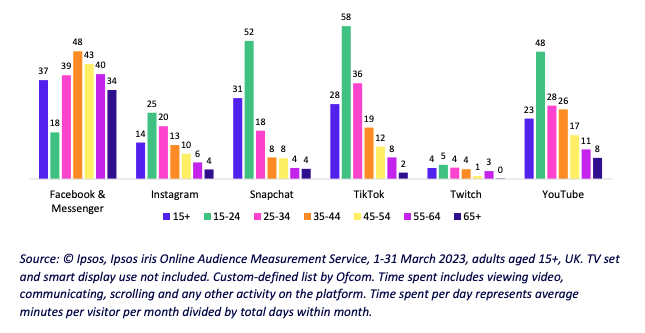
This is backed up by survey findings from the Pew Research Centre.
They found that the majority of teens use YouTube and TikTok every day, and some report using these sites almost constantly.
About three-quarters of teens (77%) say they use YouTube daily, while a smaller majority of teens (58%) say the same about TikTok.
About half of teens use Instagram (50%) or Snapchat (51%) at least once a day, while 19% report daily use of Facebook.
And some teens report using these platforms almost constantly.
For example, 19% say they use YouTube almost constantly, while 16% and 15% say the same about TikTok and Snapchat, respectively.
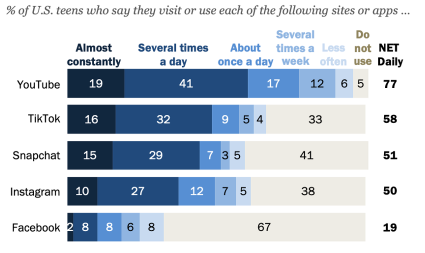
Roughly one in five teens are almost constantly on YouTube
Generative AI
Generative AI created a real shift last year when it broke into the mainstream, and in the last twelve months, there’s been a huge change in organization’s use of AI to reduce social media management, according to Hootsuite’s latest report.
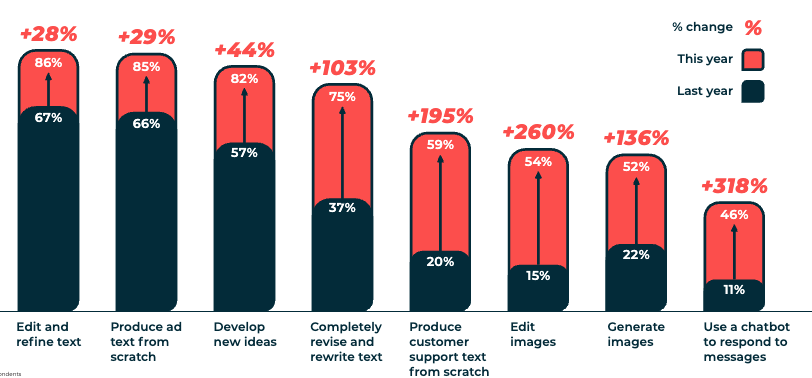
However, 62% of consumers say they are less likely to engage with and trust content if they know it was created by an AI application.
But, the good news is that younger audiences are most likely to claim they know what’s real and what’s created by AI than other generations.
They’re also more likely to trust and engage with AI content.
So in targeting younger audiences, you have the opportunity to experiment with AI with an audience that is at least generally open to experiencing and receiving it.
2. Cutting through with email communications
Last year, the UK’s Universities and Colleges Admissions Service (UCAS) shed light on student perceptions of email communications through its insightful State of Student Email report.
Despite a common misconception suggesting students overlook their emails, UCAS's findings indicate quite the opposite.
Students not only read but also digest and make decisions based on email communications.
Supporting this, Keystone Education Group surveyed 24,000 students last year, revealing that a whopping 76% of them considered email as their preferred communication channel.
In stark contrast, instant messaging lagged far behind at a mere 8.8%.
And, according to Hubspot, there has been a significant increase in email engagement, with 77% of marketers witnessing a surge over the past 12 months, prompting more than a third of brands to boost their email budgets.
In a recent report by Olark and Enrollify, email emerged as the preferred channel for a majority (38%) of education marketers in achieving their marketing and recruitment goals.
The effectiveness of email communication in the education sector is evident.
Encouragingly too, students' expectations of response times on email are less severe than in many commercial settings.
Keystone Education Group found that 5% of students expected to be responded to in less than a day, 40% expected to be responded to in 1-3 days, 40% in 1 week, and 15% in over 2 weeks.
And there’s so much potential to be had from improving response rates. In the same survey, they also found that when receiving a course inquiry:
- 38% of universities responded within a day;
- 8% within 3 days;
- 10% within a week;
- 3% within 2 weeks or more;
- and a staggering 41% of institutions didn’t respond at all.
The findings from all these surveys on the theme of email suggest there’s still great potential for creating deeper engagement through timely email communications with prospective students and their supporters.
3. Communicating with parents and families
Last year, we got some deeper insights from RNL/CampusESP into how involved parents and carers are in the university decision-making process, and what their attitudes and expectations are for communications from universities.
They surveyed more than 21,000 parents of current university students at more than 35 different institutions across the United States, with some interesting findings.
1) Most families want weekly communications from institutions
Eighty-five percent of families said they wanted weekly communication from the colleges and universities their children attend.
That accounts for 20% more families wanting weekly communications than surveyed in 2020.
Three-quarters of those surveyed said they already receive weekly communications. Still, the survey suggests there’s more headroom to communicate frequently with parents, particularly at key times in the recruitment cycle.
2) Parents welcome other communication channels
Parents have also shown more interest in alternative forms of communication.
For instance, more than four out of every 10 families stated that they’d like to receive text messages with information from institutions.
3) Connecting with parents and carers
Forty percent of surveyed parents would like additional ways to be meaningfully connected with and involved with their students’ institutions.
Examples included having a parent board, providing speaking opportunities, and meeting other prospective parents who may live in their area to support each other.
And a third of parents surveyed said they favor communications centralized in a parent/family portal.
4) The enduring influence of parents and families
In the UK, UCAS unveiled an in-depth study of more than 1,000 participants aged 13-17 last year, exploring how young people shape their futures.
In terms of the level of influence that parents and carers had on students, the study found that parents have a high degree of influence in ages 12 to 16.
Beyond this age, however, some students take matters into their own hands and the potential for guidance falls, as they seek out information more outside of the family.
The research results suggest that communicating earlier with prospective student’s parents, carers and influencers could pay dividends.

4. Open days/Campus tours and events
What students want from their open day
The Student Room did a poll with its community last year to find out the top things students want from their campus tour/open-day experience:
- 74% of the students said they wanted to assess the vibe;
- 68% said to check out the accommodation;
- and 68% said they wanted to discover what a typical day might look like.
Virtual events continue to prevail
A major shift we’ve seen in the last 12 months was the number of families attending virtual events.
This has risen significantly since 2020, a result mirrored in the survey results with nearly 40% of families stating they’d attended universities’ virtual events, with three-quarters of those families stating they were satisfied with the events attended.
5. Students are more interested in enriching their lives than increasing their incomes
The Prospective Students Survey has tracked student motivations for studying business management for many years, and this year registered a further shift in reasons for attending university which could be considered in the wider student population context.
Globally, they’ve found that prospective students are most motivated to pursue their studies to enrich their lives and develop their potential, cited by 15% more students than the next major motivator, increasing income.
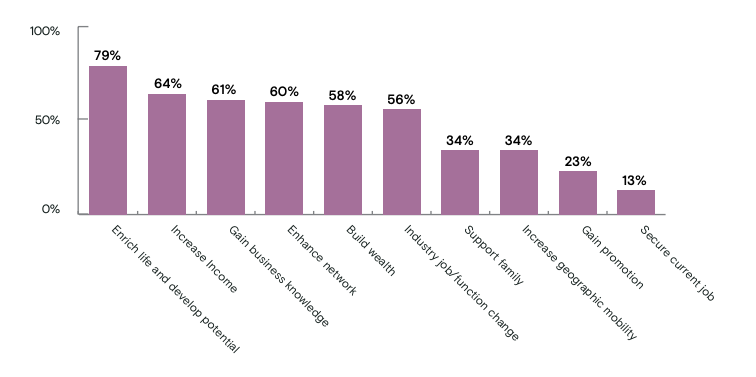
6. The view from marketers and digital teams
Responding to the emerging trends from last year, how are marketing and digital professionals reacting?
Hubspot undertook a broad survey with some key findings which we’ve pulled out below.
- 56% of marketers plan to increase their investment in TikTok this year.
- 46% of marketers are more likely to use automation this year.
Video remains the most popular and effective media format for the fourth year in a row.
Changing consumer behaviors and digital consumption have made video marketing absolutely essential for institutions.
Outside the sector, this trend prevails.
- 90% of marketers using short-form video will increase or maintain their investment this year.
- Short-form video content tops the marketers' trends leveraged last year
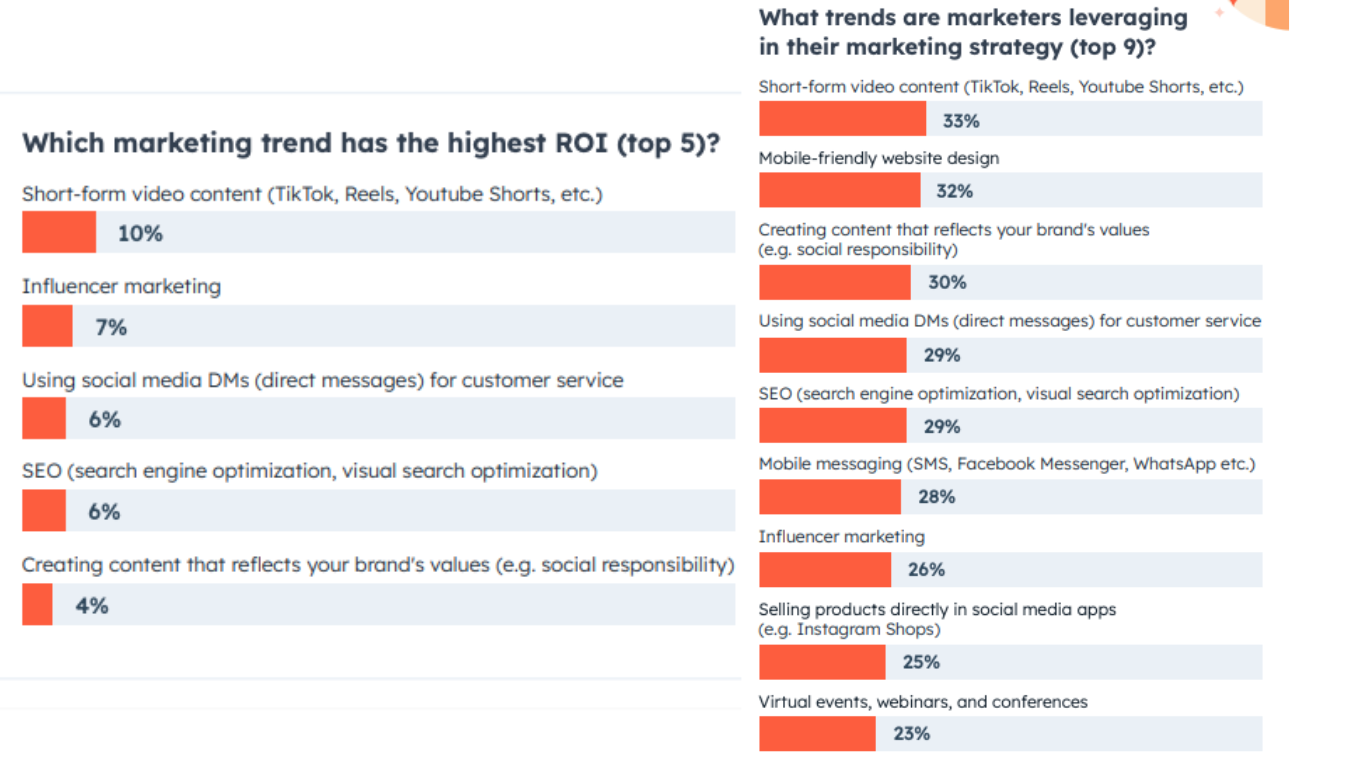
Quick Takeaways Recap
- Prioritise YouTube and TikTok for targeting prospective students.
- 2024 is the year to start experimenting with AI to support your social media management activities.
- Email marketing is still highly effective and response rates should be optimized.
- Parents and families are keen on weekly communications from the institutions their children attend. They’re also open to more use of text messages for updates and would welcome more channels for connecting with institutions.
- The top reasons for attending open days and events is to assess the vibe of a university and the accommodation and what a typical day might look like.
- Students are more interested in enriching their lives than in increasing their income potential.
Marketing and digital teams responding to surveys plan to increase their investment this year in TikTok, automation, and video content this year.
Are there any major survey findings you spotted last year?
Reach out to our team and we'll share them with our higher ed community.
 |
 |
 |
|---|

:format()//media/HE-surveys-key-stats-and-memorable-soundbites---RQ.png)